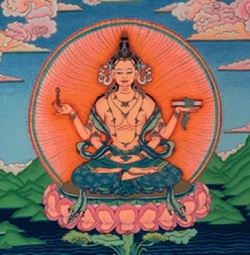 The Zen tradition has passed through patriarchal cultures, in China, Korea, Japan, and now in the West. Yet, somehow it has maintained a strong yin character, a connection to the fertile, receptive aspect of things. In his book “China on the Mind,” Christopher Bollas says that Eastern thinking is based on the “maternal order,” while Western thinking tends to privilege the “paternal order.” The maternal order is experiential, receptive, and pre-verbal. It is strongly present in the relationship with the early mother. In the maternal order are felt experiences of being an embryo and fetus, being born, being an infant, and the mother-infant bond. It tends to not be expressed in language, but rather it is presentational in nature. That is to say, it can best be expressed by gesture, body, breath, rhythm, coherence, and patterning. The patriarchal order, on the other hand, is based in words, logic, discursive thinking, and evaluation. So I’m setting out to explore the maternal order of the Zen tradition. I’m starting with Prajnaparamita, the Mother of all Buddhas. Prajnaparamita is, in one incarnation, a goddess who embodies perfect wisdom. She offers clarity of view, transcendent insight into the way things are. But don’t think this means she is pointing to some kind of ideal. Her kind of perfection isn’t something we have to strive to attain. Rather, it’s the nature of things inherently, just as they are. Prajnaparamita is also the Great Mother, the source of everything, who was worshipped and venerated in the early Ch'an tradition. She is Mother, matrix, guide, gestational body, original love and care. In the sutras, at times she is adored for her generosity, beauty, and fecundity. In another manifestation, Prajnaparamita is also a group of very important early Buddhist sutras that marked the turn to the Mahayana tradition. The Heart Sutra is a distillation of these teachings, and is chanted in Buddhist gatherings around the world. These sutras are understood as coming from the understanding of the goddess Prajnaparamita; this is her wisdom, her care. Traditionally, Prajnaparamita is the locus of the tathagarbha, the womb of being. It is from her womb that all things are born. She is the loom of origins, the source. And because she is marked by perfect wisdom, so everything that comes from her womb is marked by Buddha nature. Everything (even you) is whole and complete just as they are. This is the opposite of original sin; it is original perfection, even amid the difficulty and imperfections of life. We are born of Prajnaparamita, and we always have the potential to realize our Buddha nature, in any moment. Because Prajnaparamita can be powerfully apprehended by her presentation, it’s important to describe her attributes. She is often depicted seated on a lotus throne. The lotus represents the beauty and perfection inherent even in our muddy everyday experience. She carries a sword to cut away delusion. The sword is not used aggressively or violently, but rather to clear away confusion and mistaken views and attachments that obscure our access to her wisdom. She has a sharp quality in a way that can be helpful, to release delusions that keep us small and stuck. Finally, she is beautiful, adorned with jewels, and with a lovely face and body. In this way she allows us to fall in love with her, to gaze upon her with adoration, and also to bring this quality of devotion to other aspects of experience. When we step outside and feel in awe of a tree or flower, we have the same experience of appreciation for the beauty of the world. I recommend getting an image or statue of Prajnaparamita and allowing yourself to meditate in her company. Finally, we come to Prajnaparamita’s mantra. Mantras aren’t used much in Zen, but this one is an exception. We find it at the end of the Heart Sutra, and it’s a powerful invocation of the Great Mother. Like all mantras, the power is not so much in the meaning, but rather in the energy of the sound itself. Chanting Prajnaparamita’s mantra will invoke her into your practice, and may connect you to her capacities to give and receive love and comfort, to offer a gestational body, and to give nurturance and guidance. Try reciting the Prajnaparamita mantra 108 times and see what happens. Here it is. Gate gate paragate parasam gate bodhi svaha Zen is not usually seen as a devotional practice, but invoking the wisdom and generosity of Prajnaparamita can be a source of immense comfort and support.
5 Comments
Thonus
11/8/2018 08:21:37 am
I LIKE
Reply
Vilas Rajwade
5/23/2020 07:57:44 pm
Loved this and would like to read again, after a couple of months or so. Thanks!
Reply
cansu
1/5/2022 02:35:37 am
wonderful :)
Reply
Bobbie Kite
5/17/2022 06:22:22 am
Beautiful, I loved this. I’m curious where your work has taken you…
Reply
Lolly Newman
12/5/2022 09:21:26 am
Very interesting.
Reply
Leave a Reply. |
Details
AuthorMegan Rundel is the resident teacher at the Crimson Gate Meditation Community in Oakland, CA.. Archives
April 2020
Categories
|

 RSS Feed
RSS Feed